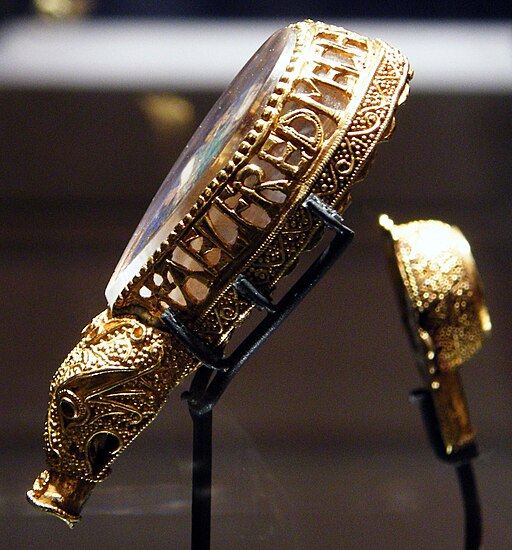
The Alfred Jewel is an Anglo-Saxon goldsmithing work made of enamel and quartz enclosed in gold. It has been dated to the late 9th century, in the reign of Alfred the Great.
The Jewel is inscribed “aelfred mec heht gewyrcan,” meaning “Alfred ordered me made.” The Jewel was once attached to a rod at its base.
The function of the Jewel was as the handle for a pointing stick used to follow the words when reading a book.
It may be the handle for one of the precious “æstels” or staffs that Alfred sent to each bishopric along with a copy of his translation of Pope Gregory the Great’s book “Pastoral Care.”
Alfred wrote in his preface to the book:
“And I will send a copy to every bishop’s see in my kingdom,
and in each book, there is an aestel of 50 mancusses
and I command, in God’s name,
that no man take the staff from the book,
nor the book from the church.”
The mancus was a term used in early medieval Europe to denote either a gold coin or thirty silver pence. This value made it worth about a month’s wages for a skilled worker, such as a craftsman or a soldier.
No other context is given, but in the context of books, the Old English word “æstel” meant a small pointer.
Other jeweled objects with a similar form have survived, all with empty sockets.

King Alfred’s Jewel – front – Ashmolean Museum of Art and Archaeology
The Alfred Jewel is made of gold, enclosing a highly polished tear-shaped piece of clear quartz, beneath which is set an enamel plaque, with an image of a man, perhaps Christ, with religious symbols.
The use of a relatively large piece of enamel to create a symbolic image is an innovation in Anglo-Saxon art, following Byzantine and Carolingian examples.
Around the sides of the crystal, there is a rim at the top that holds the rock crystal in place, above the openwork inscription.
An animal head at the base has as its snout a hollow socket, indicating that it was intended to hold a thin rod. The back is a flat gold plate engraved with a plant motif or “Tree of Life.”

King Alfred’s Jewel – front, enamel, and back – Ashmolean Museum of Art and Archaeology
The Jewel was discovered in 1693 in North Petherton, Somerset, which is about 8 miles (13 km) away from Athelney, where King Alfred founded a monastery.
Various representations of the Alfred Jewel’s image have been used as an emblem or logo by several religious and academic institutions and organizations.
The Jewel’s fame has also inspired other artworks plus many references in literature and popular culture.
Alfred Jewel
- Artifact: Alfred Jewel
- Date: Late 9th century
- Material: Enamel and quartz enclosed in gold
- Dimensions: 2 1⁄2 inches (6.4 cm) long
- Discovered: 1693, in North Petherton, Somerset, England
- Museum: Ashmolean Museum of Art and Archaeology
The Alfred Jewel
Virtual Tour of Ashmolean Museum of Art and Archaeology
Archaeology at the Ashmolean Museum
- The Alfred Jewel
- The Messiah Stradivarius
- Arab ceremonial dress owned by Lawrence of Arabia
- Narmer Macehead – Ceremonial Weapon of Ancient Egypt
- The Macehead of King Scorpion
- Sumerian King List
- The Battlefield Palette 3100 BC
- Princess Fresco
Art at the Ashmolean Museum
- “The First Anniversary of the Death of Beatrice” by Dante Gabriel Rossetti
- “Holy Family with St John the Baptist” by Michelangelo
- “A Converted British Family Sheltering a Christian Missionary from the Persecution of the Druids” by William Holman Hunt
- Chalk sketch of “The Day Dream” by Dante Gabriel Rossetti
The Life of Alfred the Great
In Search of Alfred the Great
Alfred the Great remains found?
A Virtual Tour of Museums in London
- The British Museum
- The National Gallery, London
- Tate Britain
- The Wallace Collection
- The Victoria and Albert Museum
- Queen’s Gallery, Buckingham Palace
- Courtauld Gallery
- Tate Modern, London
- Science Museum, London
- National Portrait Gallery, London
- Natural History Museum
- Charles Dickens Museum
- Hampton Court Palace
- Sherlock Holmes Museum
- British Library
- Imperial War Museum
~~~
“The saddest thing about any man is that he be ignorant, and the most exciting thing is that he knows.”
– Alfred the Great
~~~
Photo Credit: Richard M Buck flickr.com/tortipede/ (Tortipede (talk)) / CC BY-SA (creativecommons.org/licenses/by-sa/3.0); Mkooiman / CC BY-SA (creativecommons.org/licenses/by-sa/4.0); Henry Shaw (1800-1873) / Public domain
Popular this Week








 Sponsor your Favorite Page
Sponsor your Favorite Page SEARCH Search for: Search Follow UsJoin – The JOM Membership Program
Sponsor a Masterpiece with YOUR NAME CHOICE for $5
Share this:
- Tweet
